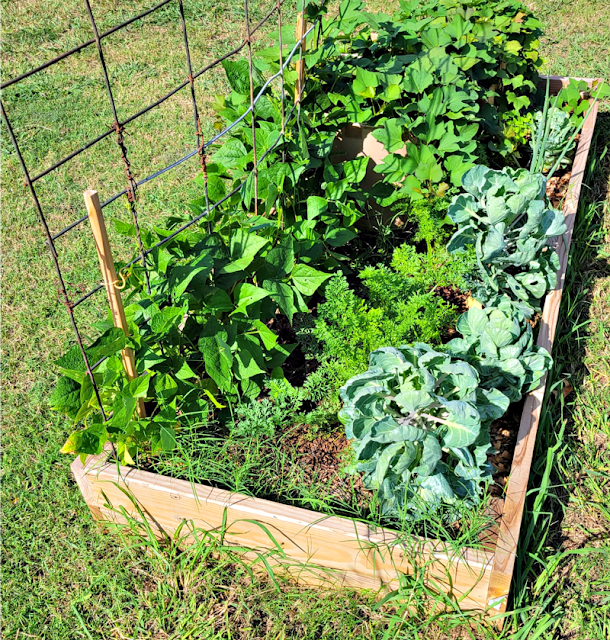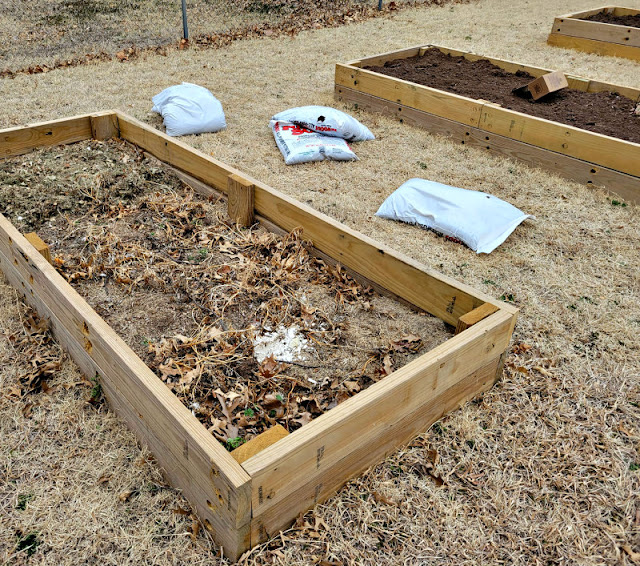Every inch of soil counts in a backyard garden, and raised garden beds can be a game-changer, an efficient solution with many advantages. From soil improvement to better use of your garden space, learn about the benefits of raised bed gardening, and about some of the disadvantages too.
Updated February 2025
The benefits of raised bed gardening
Do you want to save money on your grocery bill? Are you a bit concerned about food security and supply chain issues? Why not start a garden this year. There's no better way to take charge of your food security.
There are many ways to grow plants, including just sticking the seeds in the ground and letting them grow in a traditional row garden. You can also garden in pots and containers, and in raised beds.
Let's explore the many benefits of gardening in raised beds.
I hardly even had to water because we had plentiful rainfall all summer long.
Then we moved to Oklahoma. That was a shock to this gardener!
Our soil here is extremely poor. (Remember the Dust Bowl in the 1930's? All of Oklahoma's topsoil blew away!)
In some places our soil is clay; in others it's silica sand that doesn't hold water or nutrients at all. I struggled for several years with my traditional row garden. It's how I'd always gardened.
So I tried container gardening. Container gardening actually worked quite well for me, but there aren't enough containers in the world to grow all the plants I want to grow.
Next I decided to try raised garden beds - which really are just bottomless containers set directly on the ground.
I built those first two raised beds myself with reclaimed lumber from the old chicken run we’d replaced.
It was only the second time in my life I had used power tools - and I still have all my fingers!
you can build your own raised beds.
.
Raised beds can fix your soil problems
Raised beds can be filled with great soil, no matter what your actual ground looks like. This is one of the biggest benefits of growing in raised beds - being able to improve the soil.
Fill your raised beds up with great soil, then you can amend that soil if you want to. Some plants, like blueberries, like acidic soil, so you can customize the soil if you wish.
Other plants need really loose soil, like carrots and other root vegetables, so you can add some sand if it’s needed.
Add lots of organic material and compost to give your plants a great growing environment. Organic material such as compost can turn clay into soil that drains well, and turn sand into soil that holds moisture.
Raised beds can fix your drainage problems
Another benefit is that the soil in raised beds is faster-draining than an in-the-ground garden, because it’s higher than ground level. Gravity "does its thing" and water drains well.
Most plants don’t like to sit in soggy soil, or in the worst case scenario, a pool of water that sits on top of the ground for a while when the snow melts or after you have a good long spring rainstorm.
I have a spot in my garden where the ground is low and water sits after a big rain. I can’t walk through it without getting my feet wet, but my plants in their raised beds are high enough above ground level that they are happy.
More benefits of gardening in raised beds
Raised beds also warm up faster in the spring, so you can plant earlier in the spring. Again, because the water drains more quickly, the soil isn’t as wet and cold as the regular ground, and the soil warms up sooner.
You don’t need to till your raised garden beds either. Less work for you!
The soil isn't compacted by being walked or stepped on. A raised bed should only be as wide as you can reach into the middle, so there’s no need to walk on the soil.
Compacted soil is the main reason people till gardens, but it isn’t necessary any more.
Since you don't have to allow space to walk on the soil in your raised beds, you can plant in the entire bed, without having to leave space between rows. Another benefit: more plants in less space.
When you water your garden, the water is targeted on the plants that are growing closer together than in a traditional row garden. If you use an overhead sprinkler in a row garden, the water is spread over the entire area. Instead, with raised beds you can water the plants, not the ground between rows.
You save water as well as watering more effectively.
Planting closer together helps to deter weeds, but any weeds that do grow in raised beds are easier to remove because the soil is loose, and the roots are shallow.
so you can build your own raised beds.
.
The disadvantages of raised garden beds
Are there any disadvantages to using raised garden beds? Well, yes, there are a few.
The most notable one is that building raised beds can be expensive. However, you only have to build a raised bed once - it will continue to grow food for you at no extra cost in the future!
But you don’t have to use lumber, it’s just the most common material. There’s no law that says you have to build your garden beds with wood.
You can use any material that will keep the soil in place. Popular materials are corrugated sheet metal, big rocks or stones, concrete blocks and even tree trunks cut to length. Use what you have and save money!
As long as what you build will hold the soil in place, you’re good. Think outside the box and use what you have laying around or have access to.
Should you use pressure-treated lumber?
Many gardeners disagree about whether or not you should use pressure-treated lumber to build a raised bed garden.
Some gardeners don't want to use pressure-treated lumber for their garden beds. The treated wood will definitely last longer than untreated pine, for sure. But they fear that the chemicals used to treat the lumber will leach into the soil their food plants are growing in.
Other gardeners point out that the process of pressure-treating lumber has changed. The manufacturers say that modern pressure-treated wood is safe to use in a food gardening application.
Regular, untreated wood will decompose over time, but it will probably last much longer than you expect.
The beds that I’ve built with reclaimed lumber did have to be replaced after several years, but let’s face it, it had already been out in the weather for several years before I repurposed it in the garden.
The choice is up to you. You can use whatever makes you comfortable.
 |
| Brussel sprout transplants growing in a raised bed garden. Raised beds warm up faster in the spring so you can plant your vegetable garden earlier. |
Should you use tires as planters?
Another controversy is over using tires as raised beds, for the same reason: fear that chemicals will leach out of the tires and into the soil where food plants are grown.
But again, that choice is yours. Your garden, your rules. If you want to grow plants in tires, that's up to you.
I'd be sure to pressure-wash the tires before using them as planters.
Do raised beds save space?
Another disadvantage of using raised beds instead of traditional in-the-ground gardens is space. While the raised beds save space inside the bed, they are spaced farther apart from each other.
You can plant more intensely in a raised bed, so you need less planting area to grow the same amount of food.
How close together should you put your raised beds? I placed my mine far enough apart so we could run the lawnmower in between them. I allowed plenty of room between the beds and the garden fence too, and around the corners so we can turn the mower.
Space your raised beds far enough apart that you can push a wheelbarrow in between them. You’ll thank me for that tip.
If you have grass growing between the beds themselves, that grass has to be maintained and mowed.
Personally I don't mind mowing grass, but I also have to trim and weed-eat the tall grass that grows along the edge of the beds, where the lawnmower can’t reach. I suppose it just depends on how much you hate weed-eating!
You can always put gravel, wood chips, mulch or plain old dirt in between the beds instead of grass.
so you can build your own raised beds.
The cost to fill up the beds with soil
Then there is the cost of filling those raised beds with good soil, and yes, that can be costly. One way to keep this cost down is to build and fill a couple of beds each year, to spread the cost over time.
You'll find some tips on filling raised beds in this post, How to Start a Raised Bed Garden.
More things to consider
Remember to locate your raised beds in a sunny area, and near a water source.
If you have critters - free ranging chickens, or deer or other wildlife - you might need to enclose your garden with a fence.
While 4x8 foot beds are the most common size, you aren’t tied to that size. I am finding it much easier these days to reach the middle of my planting beds if they are 3 feet wide instead of 4 feet.
The narrower beds are much easier and more comfortable for me to plant, pull weeds, and maintain my garden.
In summary
Let's recap the advantages and disadvantages of gardening in raised garden beds.
First, the disadvantages:
- The cost to build the beds themselves can be high
- The cost to fill them with soil can also be expensive
- You may have to mow between the beds, and weedeat around the edges
But I think these disadvantages are outweighed by the benefits and advantages of having a raised bed garden.
- If your garden location is a bit low and tends to be damp, raising your plants up higher with raised beds will help the soil drain faster and keep their roots drier. (On the flip side, you may have to water more often, as raised beds dry out more quickly.)
- You'll water more effectively.
- You can plant intensively, putting plants closer together.
- You won't need to till your garden. Because you don't step in the raised beds, the soil doesn't compact and will stay light and fluffy. While weeds will grow in your raised beds, I've found them much easier to pull from this light, fertile soil than from the hard ground.
- Raised beds drain and thaw more quickly in the spring so you can plant earlier.
- You can customize the soil in the raised beds to your plants' liking. (This was my main reason for adopting this style of gardening. No more poor, depleted soil - no clay - no sand - just good growing soil.)
Your garden means your rules. You can plant however you wish, whether it’s in the ground, in containers, in raised garden beds or a combination of them all.
Just do it! Plant your garden! Start growing your own food!
so you can build your own raised beds.
.
Related posts:
Grow a Salad Garden in a Small Space
What to Grow in Your Garden, 8 Tips
Beginner's Guide to Starting Vegetable Seeds Indoors
My mission is to inspire and encourage you to live a simple, joyful life,
no matter your circumstances or where you live. Join me here:
Facebook | Pinterest | Instagram | Subscribe






.png)









